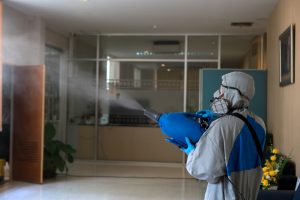Employers in New York state must have an infectious disease exposure prevention plan in place by August 5, according to a state Department of Labor spokesperson. However, the precautions under the plans only go into effect when state public health authorities make a “highly contagious communicable disease” declaration. At the moment, there is no such declaration.
Employers may choose to adopt a model prevention plan developed by the New York State Department of Labor (NYS DOL) or develop their own plan that conforms to the requirements of New York’s airborne infectious disease exposure prevention plan standard.
“The airborne infectious disease exposure prevention plans must go into effect when an airborne infectious disease is designated by the New York State Commissioner of Health as a highly contagious communicable disease that presents a serious risk of harm to the public health,” an NYS DOL spokesperson said in an e-mail.
New York’s airborne infectious disease exposure prevention standard was authorized by the New York Health and Essential Rights (NY HERO) Act (S.1034B/A.2681B), signed into law on May 5 by New York Governor Andrew Cuomo (D). The NY HERO Act and the standard it authorizes apply to all employers in the state.
There is an exemption from the state standard for healthcare and healthcare support services employers that fall under the federal COVID-19 emergency temporary standard (ETS). The Occupational Safety and Health Administration (OSHA) released text of the ETS on June 10. It became effective immediately on June 21 with its publication in the Federal Register.
Federal OSHA currently exercises workplace safety and health authority over private sector employers in the state. The New York Public Employee Safety and Health (PESH) Bureau, part of the NYS DOL, is authorized under an OSHA-approved state plan to cover all state and local government workers in the state.
OSHA did not respond to a request for comment on the NY HERO Act or the state’s airborne infectious disease exposure prevention standard.
Despite the PESH’s authority under the New York state plan, the airborne infectious disease exposure prevention standard does not apply to “employees or independent contractors of the state, any political subdivision of the state, a public authority, or any other governmental agency or instrumentality,” according to the NYS DOL fact sheet.
The standard does not apply to endemic or seasonal infectious disease like seasonal influenza unless the state Commissioner of Health designates it as a highly communicable disease posing a serious risk of harm to public health.
Prevention programs under the standard must include provisions for cleaning and disinfection, face coverings, hand hygiene, and physical distancing, as well as personal protective equipment (PPE). While PPE listed in the state standard includes respirators and provided PPE must fit the employee, the standard does not specify compliance with the federal respiratory protection program standard. In addition to respirator fit testing, all private sector U.S. employers must comply with medical evaluation and training requirements under OSHA’s respiratory protection program standard.
Exposure controls in an employer’s prevention plan must include health screenings at the beginning of a work shift that conform to guidance issued by the State Department of Health or Centers for Disease Control and Prevention (CDC) for a designated disease. Employers also must follow CDC or State Department of Health protocols regarding testing, isolation, and quarantine before allowing employees to return to the workplace or site.
Other exposure control measures in a prevention plan must include:
- Providing employees with face coverings recommended by the CDC or state Department of Health at no cost to the employees;
- Physical distancing of at least 6 feet apart from other individuals;
- Providing hand-washing facilities with an adequate supply of tepid or warm potable water, soap, and single-use towels or air-drying machines or hand sanitizers containing at least 60 percent alcohol when providing hand-washing facilities is not feasible or practical; and
- Immediately, or as soon as feasible, cleaning and disinfecting surfaces believed to be contaminated with potential infectious materials and frequently cleaning and disinfecting frequently touched surfaces, such as handrails, doorknobs, and elevator buttons, throughout the workday, as well as shared equipment, tools, and workspaces.
The standard also contains antiretaliation provisions.
The August 5 deadline for New York employers to adopt an airborne infectious disease exposure plan is 30 days after the NYS DOL publicly released the standard and model prevention plan, according to the department spokesperson.

